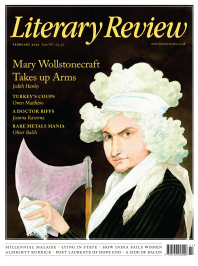Simon J V Malloch
Did He Really Fiddle?
Rome is Burning: Nero and the Fire That Ended a Dynasty
By Anthony A Barrett
Princeton University Press 368pp £25
On 19 July AD 64, fire engulfed the Circus Maximus in Rome. Nero returned from Antium when the blaze threatened his palace on the Palatine hill. He involved himself in firefighting and organised relief measures. After some nine days the fire was extinguished, leaving two thirds of the city damaged or destroyed. Nero was widely thought to be responsible for torching Rome. He attempted to shift the blame onto local Christians, many of whom were executed in spectacular fashion. In the aftermath he set about rebuilding the city. The centrepiece of this programme was a magnificent architectural and artistic complex known as the Golden House. It remained unfinished at Nero’s death four years later.
This thumbnail sketch is possible only because accounts of the fire happen to survive in major literary sources: in the Annals by the historian Tacitus (c 56–120); in the life of Nero by the biographer Suetonius (c 69–130); and in a Byzantine epitome of the work of the historian Cassius Dio (c 150–235). For Anthony Barrett this relatively rich literary record renders the fire of 64 unique among the many that ravaged Rome. The problem remains, to quote Moses Finley, that these writers ‘confused the account of the great fire … so effectively that no one has been able to unscramble it satisfactorily’.
Take a simple example. All three authors mention Nero dressing up in costume during the fire and singing about the fall of Troy, ‘drawing a comparison’, Tacitus remarks, ‘between present misfortunes and ancient disasters’. Yet there is disagreement as to where and indeed whether Nero gave this performance. Suetonius places

Sign Up to our newsletter
Receive free articles, highlights from the archive, news, details of prizes, and much more.@Lit_Review
Follow Literary Review on Twitter
Twitter Feed
How to ruin a film - a short guide by @TWHodgkinson:
Thomas W Hodgkinson - There Was No Sorcerer
Thomas W Hodgkinson: There Was No Sorcerer - Box Office Poison: Hollywood’s Story in a Century of Flops by Tim Robey
literaryreview.co.uk
How to ruin a film - a short guide by @TWHodgkinson:
Thomas W Hodgkinson - There Was No Sorcerer
Thomas W Hodgkinson: There Was No Sorcerer - Box Office Poison: Hollywood’s Story in a Century of Flops by Tim Robey
literaryreview.co.uk
Give the gift that lasts all year with a subscription to Literary Review. Save up to 35% on the cover price when you visit us at https://literaryreview.co.uk/subscribe and enter the code 'XMAS24'